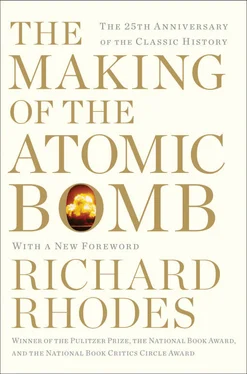In 1900 Rutherford reported the discovery of a radioactive gas emanating from the radioactive element thorium. 140Marie and Pierre Curie soon discovered that radium (which they had purified from uranium ores in 1898) also gave off a radioactive gas. Rutherford needed a good chemist to help him establish whether the thorium “emanation” was thorium or something else; fortunately he was able to shanghai a young Oxford man at McGill, Frederick Soddy, of talent sufficient eventually to earn a Nobel Prize. “At the beginning of the winter [of 1900],” Soddy remembers, “Ernest Rutherford, the Junior Professor of Physics, called on me in the laboratory and told me about the discoveries he had made. He had just returned with his bride from New Zealand… but before leaving Canada for his trip he had discovered what he called the thorium emanation…. I was, of course, intensely interested and suggested that the chemical character of the [substance] ought to be examined.” 141
The gas proved to have no chemical character whatsoever. That, says Soddy, “conveyed the tremendous and inevitable conclusion that the element thorium was slowly and spontaneously transmuting itself into [chemically inert] argon gas!” Soddy and Rutherford had observed the spontaneous disintegration of the radioactive elements, one of the major discoveries of twentieth-century physics. 142They set about tracing the way uranium, radium and thorium changed their elemental nature by radiating away part of their substance as alpha and beta particles. They discovered that each different radioactive product possessed a characteristic “half-life,” the time required for its radiation to reduce to half its previously measured intensity. The half-life measured the transmutation of half the atoms in an element into atoms of another element or of a physically variant form of the same element—an “isotope,” as Soddy later named it. 143Half-life became a way to detect the presence of amounts of transmuted substances—“decay products”—too small to detect chemically. The half-life of uranium proved to be 4.5 billion years, of radium 1,620 years, of one decay product of thorium 22 minutes, of another decay product of thorium 27 days. Some decay products appeared and transmuted themselves in minute fractions of a second—in the twinkle of an eye. It was work of immense importance to physics, opening up field after new field to excited view, and “for more than two years,” as Soddy remembered afterward, “life, scientific life, became hectic to a degree rare in the lifetime of an individual, rare perhaps in the lifetime of an institution.” 144
Along the way Rutherford explored the radiation emanating from the radioactive elements in the course of their transmutation. He demonstrated that beta radiation consisted of high-energy electrons “similar in all respects to cathode rays.” He suspected, and later in England conclusively proved, that alpha particles were positively charged helium atoms ejected during radioactive decay. 145Helium is found captured in the crystalline spaces of uranium and thorium ores; now he knew why.
An important 1903 paper written with Soddy, “Radioactive change,” offered the first informed calculations of the amount of energy released by radioactive decay:
It may therefore be stated that the total energy of radiation during the disintegration of one gram of radium cannot be less than 10 8[i.e., 100,000,000] gram-calories, and may be between 10 9and 10 10gram-calories…. The union of hydrogen and oxygen liberates approximately 4 × 10 3[i.e., 4,000] gram-calories per gram of water produced, and this reaction sets free more energy for a given weight than any other chemical change known. The energy of radioactive change must therefore be at least twenty-thousand times, and may be a million times, as great as the energy of any molecular change. 146
That was the formal scientific statement; informally Rutherford inclined to whimsical eschatology. A Cambridge associate writing an article on radioactivity that year, 1903, considered quoting Rutherford’s “playful suggestion that, could a proper detonator be found, it was just conceivable that a wave of atomic disintegration might be started through matter, which would indeed make this old world vanish in smoke.” Rutherford liked to quip that “some fool in a laboratory might blow up the universe unawares.” If atomic energy would never be useful, it might still be dangerous. 147, 148
Soddy, who returned to England that year, examined the theme more seriously. Lecturing on radium to the Corps of Royal Engineers in 1904, he speculated presciently on the uses to which atomic energy might be put:
It is probable that all heavy matter possesses—latent and bound up with the structure of the atom—a similar quantity of energy to that possessed by radium. If it could be tapped and controlled what an agent it would be in shaping the world’s destiny! The man who put his hand on the lever by which a parsimonious nature regulates so jealously the output of this store of energy would possess a weapon by which he could destroy the earth if he chose. 149
Soddy did not think the possibility likely: “The fact that we exist is a proof that [massive energetic release] did not occur; that it has not occurred is the best possible assurance that it never will. We may trust Nature to guard her secret.”
H. G. Wells thought Nature less trustworthy when he read similar statements in Soddy’s 1909 book Interpretation of Radium. “My idea is taken from Soddy,” he wrote of The World Set Free. “One of the good old scientific romances,” he called his novel; it was important enough to him that he interrupted a series of social novels to write it. 150Rutherford’s and Soddy’s discussions of radioactive change therefore inspired the sciencefiction novel that eventually started Leo Szilard thinking about chain reactions and atomic bombs.
In the summer of 1903 the Rutherfords visited the Curies in Paris. Mme. Curie happened to be receiving her doctorate in science on the day of their arrival; mutual friends arranged a celebration. “After a very lively evening,” Rutherford recalled, “we retired about 11 o’clock in the garden, where Professor Curie brought out a tube coated in part with zinc sulphide and containing a large quantity of radium in solution. 151The luminosity was brilliant in the darkness and it was a splendid finale to an unforgettable day.” The zinc-sulfide coating fluoresced white, making the radium’s ejection of energetic particles on its progess down the periodic table from uranium to lead visible in the darkness of the Paris evening. The light was bright enough to show Rutherford Pierre Curie’s hands, “in a very inflamed and painful state due to exposure to radium rays.” Hands swollen with radiation burns was another object lesson in what the energy of matter could do.
A twenty-six-year-old German chemist from Frankfurt, Otto Hahn, came to Montreal in 1905 to work with Rutherford. Hahn had already discovered a new “element,” radiothorium, later understood to be one of thorium’s twelve isotopes. He studied thorium radiation with Rutherford; together they determined that the alpha particles ejected from thorium had the same mass as the alpha particles ejected from radium and those from another radioactive element, actinium. The various particles were probably therefore identical—one conclusion along the way to Rutherford’s proof in 1908 that the alpha particle was inevitably a charged helium atom. Hahn went back to Germany in 1906 to begin a distinguished career as a discoverer of isotopes and elements; Leo Szilard encountered him working with physicist Lise Meitner at the Kaiser Wilhelm Institute for Chemistry in the 1920s in Berlin.
Rutherford’s research at McGill unraveling the complex transmutations of the radioactive elements earned him, in 1908, a Nobel Prize—not in physics but in chemistry. He had wanted that prize, writing his wife when she returned to New Zealand to visit her family in late 1904, “I may have a chance if I keep going,” and again early in 1905, “They are all following on my trail, and if I am to have a chance for a Nobel Prize in the next few years I must keep my work moving.” The award for chemistry rather than for physics at least amused him. 152, 153“It remained to the end a good joke against him,” says his son-in-law, “which he thoroughly appreciated, that he was thereby branded for all time as a chemist and no true physicist.” 154
Читать дальше












